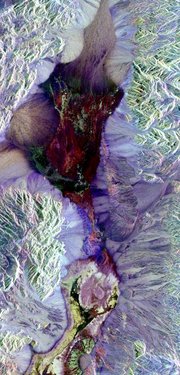Synthetic aperture radar
|
|

Synthetic aperture radar (SAR) is a form of radar in which sophisticated post-processing of radar data is used to produce a very narrow effective beam. It can only be used by moving instruments over relatively immobile targets, but it has seen wide applications in remote sensing and mapping.
| Contents |
Basic operation
In a typical SAR application, a single radar antenna will be attached to the side of an aircraft. A single pulse from the antenna will be rather broad (several degrees) because diffraction requires a large antenna to produce a narrow beam. The pulse will also be broad in the vertical direction; often it will illuminate the terrain from directly beneath the aircraft out to the horizon. However, if the terrain is approximately flat, the time at which echoes return allows points at different distances from the flight track to be distinguished. Distinguishing points along the track of the aircraft is difficult with a small antenna. However, if the amplitude and phase of the signal returning from a given piece of ground are recorded, and if the aircraft emits a series of pulses as it travels, then the results from these pulses can be combined. Effectively, the series of observations can be combined just as if they had all been made simultaneously from a very large antenna; this process creates a synthetic aperture much larger than the length of the antenna (and in fact much longer than the aircraft itself).
Combining the series of observations is done using Fast Fourier Transform techniques; it requires significant computational resources, and is normally done at a ground station after the observation is complete. The result is a map of radar reflectivity (including both amplitude and phase) on the ground. The phase information is, in the simplest applications, discarded. The amplitude information, however, contains information about ground cover, in much the same way that a black-and-white picture does. Interpretation is not simple, but a large body of experimental results has been accumulated by flying test flights over known terrain.
More complex operation

The basic design of a synthetic aperture radar system can be enhanced in various ways to collect more information. Most of these methods use the same basic principle of combining many pulses to form a synthetic aperture, but they may involve additional antennas or significant additional processing.
Polarimetry
Radar waves have a polarization. Different materials reflect radar waves with different intensities, but anisotropic materials such as grass often reflect different polarizations with different intensities. Some materials will also convert one polarization into another. By emitting a mixture of polarizations and using receiving antennas with a specific polarization, several different images can be collected from the same series of pulses. Frequently three such images are used as the three color channels in a synthesized image. This is what has been done in the picture above. Interpretation of the resulting colors requires significant testing of known materials.
Interferometry
Rather than discarding the phase information, information can be extracted from it. If two observations of the same terrain from very similar positions are available, a great deal of interesting information can be extracted. This technique is called interferometric SAR or InSAR.
If the two samples are obtained simultaneously (perhaps by placing two antennas on the same aircraft, some distance apart), then any phase difference will contain information about the angle from which the radar echo returned. Combining this with the distance information, one can determine the position in three dimensions of the image pixel. In other words, one can extract terrain altitude as well as radar reflectivity, producing a digital elevation model with a single airplane pass. One aircraft application at the Canada Center for Remote Sensing produced digital elevation maps with a resolution of 5 m and altitude errors also on the order of 5 m.
If the two samples are separated in time, perhaps from two different flights over the same terrain, then there are two possible sources of phase shift. The first is terrain altitude, as discussed above. The second is terrain motion: if the terrain has shifted between obervations, it will return a different phase. The amount of shift required to cause a significant phase difference is on the order of the wavelength used. This means that if the terrain shifts by centimeters, it can be seen in the resulting image (A digital elevation map must be available in order to separate the two kinds of phase difference; a third pass may be necessary in order to produce one).
This second method offers a powerful tool in geology and geography. Glacier flow can be mapped with two passes. Maps showing the land deformation after a minor earthquake or after a volcanic eruption (showing the shrinkage of the whole volcano by several centimeters) have been published.
Ultra-wideband SAR
Normal radar emits pulses with a very narrow range of frequencies. This places a lower limit on the pulse length (and therefore the resolution in the distance direction) but greatly simplifes the electronics. Interpretation of the results is also eased by the fact that the material response must be known only in a narrow range of frequencies.
Ultra-wideband radar emits very short pulses consisting of a very wide range of frequencies, from zero up to the radar's normal operating frequency. Such pulses allow high distance resolution but much of the information is concentrated in relatively low frequencies (with long wavelengths). Thus such systems require very large receiving apertures to obtain correspondingly high resolution along the track. This can be achieved with synthetic aperture techniques.
The fact that the information is captured in low frequencies means that the most relevant material properties are those at lower frequencies than for most radar systems. In particular, such radar can penetrate some distance into foliage and soil.
Doppler Beam Sharpening
A commonly used technique for SAR systems is called Doppler Beam Sharpening. Because the real aperture of the RADAR antenna is so small (compared to the wavelength in use), the RADAR energy spreads over a wide area (usually many degrees wide in a direction ortho-normal (right angle) to the direction of the platform (aircraft). Doppler Beam Sharpening takes advantage of the motion of the platform in that targets ahead of the platform return a Doppler up-shifted signal (slightly higher in frequency) and targets behind the platform return a Doppler down-shifted signal (slightly lower in frequency). The amount of shift varies with the angle forward or backward from the ortho-normal direction. By knowing the speed of the platform, target signal return is placed in a specific angle "bin" that changes over time. Signals are integrated over time and thus the RADAR "beam" is synthetically reduced to a much smaller aperture - or more accurately (and based on the ability to distinguish smaller doppler shifts) the system can have hundreds of very "tight" beams concurrently. This technique dramatically improves angular resolution; however, it is far more difficult to take advantage of this technique for range resolution.
Chirped (Pulse Compressed) Radars
A common techniqe for many RADAR systems (sometimes found in SAR systems) is to "chirp" the signal. In a "chirped" radar, the pulse is allowed to be much longer (which usually hinders range resolution - but increases the probability of detection because more energy is returned), but this longer pulse is also allowed to have a frequency shift during the pulse (hence the chirp or frequency shift). When the "chirped" signal is returned, it is passed to a dispersive delay line (often a SAW device (Surface Acoustic Wave) that has the property of varying velocity of propogation based on frequency. This technique "compresses" the pulse in time - thus having the effect of a much shorter pulse (improved range resolution) while having the benefit of longer pulse length (much more signal returned).
Data collection
Highly accurate data can be collected by aircraft overflying the terrain in question. In the 1980s, as a prototype for instruments to be flown on the NASA Space shuttles, NASA operated a synthetic aperture radar on a NASA CV-990. However, in 1986, this plane crashed on takeoff. In 1988, NASA rebuilt a C, L, and P-band SAR to fly on the NASA DC-8 aircraft. Called AIRSAR, it flew missions at sites around the world until 2004. Another such aircraft was flown by the Canada Center for Remote Sensing until about 1996 when it was decommissioned for cost reasons. Most land-surveying applications are now carried out by satellite observation. Satellites such as ERS-1, JERS-1, and RADARSAT-1 were launched explicitly to carry out this sort of observation. Their capabilities differ, particularly in their support for interferometry, but all have collected tremendous amounts of valuable data. The Space Shuttle has also carried synthetic aperture radar equipment. SIR-A flew on the first dedicated science mission of the space shuttle in 1982. SIR-b flew in 1984 on the space shuttle. SIR-c flew on the space shuttle endeavour twice in 1994.
The Magellan space probe mapped the surface of Venus over several years using synthetic aperture radar.
Synthetic aperture radar was first used by NASA on JPL's Seasat oceanographic satellite in 1978 (this mission also carried an altimeter and a scatterometer); it was later developed more extensively on the Spaceborne Imaging Radar (SIR) missions on the space shuttle in 1981, 1984 and 1994. The Cassini mission to Saturn is currently using SAR to map the surface of the planet's major moon Titan, whose surface is partially hidden from direct optical inspection by atmospheric haze.
The Mineseeker Project ([1] (http://www.mineseeker.com/)) is designing a system for determining whether regions contain landmines based on a blimp carrying ultra-wideband synthetic aperture radar. Initial trials show promise; the radar is able to detect even buried plastic mines.
See also
- radar
- remote sensing
- Earth observation satellite
- Magellan space probe
- ISAR
External links
- The Imaging Radar Home Page (http://southport.jpl.nasa.gov) (NASA SAR missions)
- Airborne Synthetic Aperture Radar (AIRSAR) (http://airsar.jpl.nasa.gov) ) (NASA Airborne SAR)
- The CCRS airborne SAR page (http://www.ccrs.nrcan.gc.ca/ccrs/data/satsens/airborne/sarbro/sbmain_e.html) (Canadian airborne missions)
- RADARSAT international (http://www.rsi.ca/) (Canadian radar satellites)
- The ERS missions (http://earth.esa.int/ers/) (European radar satellites)
- The JERS satellites (http://www.eorc.nasda.go.jp/JERS-1/) (Japanese radar satellites)
- Images from the Space Shuttle SAR instrument (http://www.jpl.nasa.gov/radar/sircxsar/)
- The Mineseeker Project (http://www.mineseeker.com/) has technical information about ultra-wideband SAR
- The Alaska Satellite Facility (http://www.asf.alaska.edu/) has numerous tehnical documents, including an introductory text (http://www.asf.alaska.edu/SciSARuserGuide.pdf) on SAR theory and scientific applicationsde:Synthetic Aperture Radar
